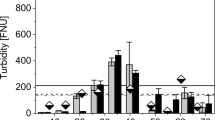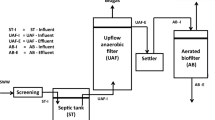Abstract
This study was conducted to evaluate the performance of High-Rate Filter (HRF) as an alternative process to Conventional Primary Sedimentation (CPS) processes and the performance of different configurations of activated sludge and biofilter systems with anaerobic/aerobic zones for efficient textile wastewater treatment. The performance efficiency of the HRF with much shorter hydraulic retention time (HRT: 0.3 h) was very similar to that of the CPS process with a longer HRT of 3.0 h. The highest efficiencies of the systems were achieved by configuring anoxic:anaerobic:oxic:oxic zones for an activated sludge system and anaerobic:oxic: anoxic zones for a biofilter system, respectively. In particular, under the most efficient configurations of the systems, the performance of the biofilter system achieved a higher efficiency than that of the activated sludge system. Compared with the existing physicochemical-sequencing batch reactor system, the most efficient configurations of the HRF/activated sludge system and the HRF/biofilter system with a shorter HRT achieved both higher pollutant removal efficiency and lower sludge production.
Similar content being viewed by others
References
Alinsafi, A., Motta, M., Bonte, S., Pons, M. N., and Benhammou, A. (2006). “Effect of variability on the treatment of textile dyeing wastewater by activated sludge.” Dyes and Pigments, Vol. 69, Nos. 1–2, pp. 31–39.
APHA, AWWA, and WEF (1998). Standard methods for the examination of water and wastewater, 20th Ed., American Public Health Association, Washington, D.C.
Aragones-Beltran, P., Mendoza-Roca, J.A., Bes-Pia, A., Garcia-Melon, M., and Parra-Ruiz, E. (2009). “Application of multicritria decision analysis to jar-test results for chemicals selection in the physicalchemical treatment of textile wastewater.” Journal of Hazardous Materials, Vol. 164, No. 1, pp. 288–295.
Banat, I. M., Nigam, P., Singh, D., and Marchant, R. (1996). “Microbial decolourization of textile-dye containing effluents: A review.” Bioresource Technology, Vol. 58, No. 3, pp. 217–227.
Brik, M., Schoeberl, P., Chamam, B., Braun, R., and Fuchs, W. (2006). “Advanced treatment of textile wastewater towards reuse using a membrane bioreactor.” Process Biochemistry, Vol. 41, No. 8, pp. 1751–1757.
Buitron, G., Quezada, M., and Moreno, G. (2004). “Aerobic degradation of the azo dye acid red 151 in a sequencing batch biofilter.” Bioresource Technology, Vol. 92, No. 2, pp. 143–149.
Chinwetkitvanish, S., Tuntoolvest, M., and Pansward, T. (2000). “Anaerobic decolourisation of reactive dyebath effluents by a two stage UASB system with topical co-substrate.” Water Research, Vol. 34, No. 8, pp. 2223–2232.
Coughlin, M. F., Kinkle, B. K., and Bishop, P. L. (2003). “High performance degradation of azo dye acid orange 7 and sulfanilic acid in a laboratory scale reactor after seeding with cultured bacterial strains.” Water Research, Vol. 37, No. 11, pp. 2757–2763.
Ekama, G. A. and Wentzel, M. C. (1999). “Denitrification kinetics in biological N and P removal activated sludge systems treating municipal wastewaters.” Water Science and Technology, Vol. 39, No. 6, pp. 69–77.
Ersu, C. B., Ong, S. K., Arslankaya, E., and Brown, P. (2008). “Comparison of recirculation configurations for biological nutrient removal in a membrane bioreactor.” Water Research, Vol. 42, Nos. 6–7, pp. 1651–1663.
Georgiou, D. and Aivasidis, A. (2006). “Decolourisation of textile wastewater by means of a fluidized-bed loop reactor and immobilized anaerobic bacteria.” Journal of Hazardous Materials, Vol. 135, Nos. 1–3, pp. 372–377.
Hyun, K. S. and Lee, S. J. (2007). “Study on biological pretreatment process of wastewater of high organic level for effective blended treatment with domestic wastewater.” Jour. KSWST, Vol. 15, No. 3, pp. 55–64.
Kapdan, I. K. and Alparslan, S. (2005). “Application of anaerobicaerobic sequential treatment system to real textile wastewater for color and COD removal.” Enzyme and Microbial Technology, Vol. 36, Nos. 2–3, pp. 273–279.
Kapdan, I. K. and Kargi, F. (2002). “Biological decolorization of textile dyestuff containing wastewater by Coriolus vesicolor in a rotating biological contactor.” Enzyme and Microbial Technology, Vol. 30, No. 2, pp. 195–199.
Khelifi, E., Gannoun, H., Touhami, Y., Bouallagui, H., and Hamdi, M. (2008). “Aerobic decolourization of the indigo dye-containing textile wastewater using continuous combined bioreactors.” Journal of Hazardous Materials, Vol. 152, No. 2, pp. 683–689.
Kong, H. and Wu, H. (2008). “Pretreatment of textile dyeing wastewater using an anoxic baffled reactor.” Bioresource Technology, Vol. 99, No. 16, pp. 7886–7891.
Liakou, S., Pavlou, S., and Lyberatos, G. (1998). “Ozonation of azo dyes.” Water Science & Technology, Vol. 35, No. 4, pp. 279–286.
Lourenco, N. M., Novais, J. M., and Pinherio, H. M. (2001). “Effect of some operational parameters on textile dye biodegradation in sequential batch reactor.” Journal of Biotechnology, Vol. 89, Nos. 2–3, pp. 163–174.
Mendoza-Espinosa, L. and Stephenson, T. (1999). “A review of Biological Aerated Filters (BAFs) for wastewater treatment.” Environ. Eng. Sci. Vol. 16, No. 3, pp. 201–216.
Monclus, H., Sipma, J., Ferrero, G., Rodriguez-Roda, I., and Comas, J. (2010). “Biological nutrient removal in an MBR treating municipal wastewater with special focus on biological phosphorus removal.” Bioresource Technology, Vol. 101, No. 11, pp. 3984–3991.
Oehmen, A., Lemos, P. C., Carvalho, G., Yuan, Z., Keller, J., Blackall, L. L., and Reis, M. A. M. (2007). “Advances in enhanced biological phosphorus removal: From micro to macro scale.” Water Research, Vol. 41, No. 11, pp. 2271–2300.
Sandhya, S., Padmavathy, S., Swaminathan, K., Subrahmanyam, Y. V., and Kaul, S. N. (2005). “Microaerophilic-aerobic sequential batch reactor for treatment of azo dyes containing simulated wastewater.” Process Biochemistry, Vol. 40, No. 2, pp. 885–890.
Sponza, D. T. and Isik, M. (2002). “Decolourisation and azo dye degradation by anaerobic/aerobic sequential process.” Enzyme Microbial Technology, Vol. 31, Nos.1–2, pp.102–110.
Talarposhti, A. M., Donnely, T., Anderson, G. K. (2001). “Color removal from a simulated dye wastewater using two phase anaerobic packed bed reactor.” Water Research, Vol. 35, No. 2, pp. 425–432.
Tan, N. C. G., Borger, A., Slenders, P., Svitelskaya, A., Lettinga, G., and Field, J. A. (2000). “Degradation of azo dye Mordant Yellow 10 in a sequential anaerobic and bioaugmented aerobic bioreactor.” Water Science & Technoogy, Vol. 42, Nos. 5–6, pp. 337–344.
van Benthum, W. A. J., Garrido, J. M., and Mathijssen, J. P. M. (1998). “Nitrogen removal in intermittently aerated biofilm airlift reactor.” J. Environ. Eng. ASCE, Vol. 124, No. 3, pp. 239–248.
Westerman, P. W., Bicudo, J. R., and Kantardjieff, A. (2000). “Upflow biological aerated filters for the treatment of flushed swine manure.” Bioresource Technology, Vol. 74, No. 3, pp. 181–190.
Zhang, H., Wang, X., Xiao, J., Yang, F., and Zhang, J. (2009). “Enhanced biological nutrient removal using MUCT-MBR system.” Bioresource Technology, Vol. 100, No. 3, pp. 1048–1054.
Author information
Authors and Affiliations
Corresponding author
Rights and permissions
About this article
Cite this article
Kang, Y., Won, T. & Hyun, K. Efficient treatment of real textile wastewater: Performance of activated sludge and biofilter systems with a high-rate filter as a pre-treatment process. KSCE J Civ Eng 16, 308–315 (2012). https://doi.org/10.1007/s12205-012-1479-7
Received:
Revised:
Accepted:
Published:
Issue Date:
DOI: https://doi.org/10.1007/s12205-012-1479-7




